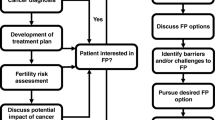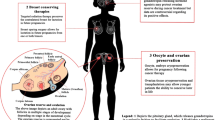Abstract
Purpose of Review
There are competing risks and benefits of cancer therapies and fertility preservation in young women with breast cancer. Here we discuss the impact of therapy on fertility, fertility preservation options, and emerging information in fertility issues for the breast cancer patient.
Recent Findings
All systemic forms of breast cancer treatment can impact future fertility. Pre-therapy fertility preservation may offer the best opportunity for future fertility. Shared decision making with the individual patient and clinical scenario is important. Early referral to a fertility specialist should be offered to young patients.
Summary
We find that fertility preservation options for young women diagnosed with breast cancer are currently available, but potentially under-utilized. We conclude that a multidisciplinary approach is necessary, with discussion of potential risks and benefits of fertility preservation options in the context of the patient’s clinical disease.
Similar content being viewed by others
References
Papers of particular interest, published recently, have been highlighted as: •• Of major importance
Hery C, Ferlay J, Boniol M, Autier P. Changes in breast cancer incidence and mortality in middle-aged and elderly women in 28 countries with Caucasian majority populations. Ann Oncol. 2008;19(5):1009–18. https://doi.org/10.1093/annonc/mdm593.
Merlo DF, Ceppi M, Filiberti R, et al. Breast cancer incidence trends in European women aged 20–39 years at diagnosis. Breast Cancer Res Treat. 2012;134(1):363–70. https://doi.org/10.1007/s10549-012-2031-7.
Anders CK, Johnson R, Litton J, Phillips M, Bleyer A. Breast cancer before age 40 years. Semin Oncol. 2009;36(3):237–49. https://doi.org/10.1053/j.seminoncol.2009.03.001.
Lund MJ, Trivers KF, Porter PL, Coates RJ, Leyland-Jones B, Brawley OW, et al. Race and triple negative threats to breast cancer survival: a population-based study in Atlanta, GA. Breast Cancer Res Treat. 2009;113(2):357–70. https://doi.org/10.1007/s10549-008-9926-3.
Kollias J, Elston CW, Ellis IO, Robertson JF, Blamey RW. Early-onset breast cancer--histopathological and prognostic considerations. Br J Cancer. 1997;75(9):1318–23. http://www.ncbi.nlm.nih.gov/pubmed/9155052. Accessed 30 Jan 2019.
Gnerlich JL, Deshpande AD, Jeffe DB, Sweet A, White N, Margenthaler JA. Elevated breast cancer mortality in women younger than age 40 years compared with older women is attributed to poorer survival in early-stage disease. J Am Coll Surg. 2009;208(3):341–7. https://doi.org/10.1016/j.jamcollsurg.2008.12.001.
Chen H, Zhou M, Tian W, Meng K, He H. Effect of Age on Breast Cancer Patient Prognoses: A Population-Based Study Using the SEER 18 Database. Coleman WB, ed. PLoS One. 2016;11(10):e0165409. doi:https://doi.org/10.1371/journal.pone.0165409.
Meirow D, Schiff E. Appraisal of chemotherapy effects on reproductive outcome according to animal studies and clinical data. J Natl Cancer Inst Monogr. 2005;2005(34):21–5. https://doi.org/10.1093/jncimonographs/lgi025.
Maltaris T, Boehm D, Dittrich R, Seufert R, Koelbl H. Reproduction beyond cancer: A message of hope for young women 2006. doi:https://doi.org/10.1016/j.ygyno.2006.08.003.
NCCN. Pregnancy after cancer. https://www.nccn.org/patients/resources/life_after_cancer/pregnancy.aspx. Accessed 17 Feb 2019.
Pagani O, Ruggeri M, Manunta S, Saunders C, Peccatori F, Cardoso F, et al. Pregnancy after breast cancer: are young patients willing to participate in clinical studies? Breast. 2015;24(3):201–7. https://doi.org/10.1016/j.breast.2015.01.005.
Henry NL, Xia R, Schott AF, McConnell D, Banerjee M, Hayes DF. Prediction of postchemotherapy ovarian function using markers of ovarian reserve. Oncologist. 2014;19(1):68–74. https://doi.org/10.1634/theoncologist.2013-0145.
Rossi L, Pagani O. Impact of breast cancer treatment on fertility. In: Breast Cancer, fertility preservation and reproduction. Cham: Springer International Publishing; 2015. p. 29–43. https://doi.org/10.1007/978-3-319-17278-1_3.
Jung M, Shin HJ, Rha SY, Jeung HC, Hong S, Moon YW, et al. The clinical outcome of chemotherapy-induced amenorrhea in premenopausal young patients with breast cancer with long-term follow-up. Ann Surg Oncol. 2010;17(12):3259–68. https://doi.org/10.1245/s10434-010-1172-3.
Oktem O, Oktay K. Quantitative assessment of the impact of chemotherapy on ovarian follicle reserve and stromal function. Cancer. 2007;110(10):2222–9. https://doi.org/10.1002/cncr.23071.
Morgan S, Anderson RA, Gourley C, Wallace WH, Spears N. How do chemotherapeutic agents damage the ovary? Hum Reprod Update. 2012;18(5):525–35. https://doi.org/10.1093/humupd/dms022.
Minton SE, Munster PN. Chemotherapy-induced amenorrhea and fertility in women undergoing adjuvant treatment for breast cancer. Cancer Control. 2002;9(6):466–72. https://doi.org/10.1177/107327480200900603.
Fornier MN, Modi S, Panageas KS, Norton L, Hudis C. Incidence of chemotherapy-induced, long-term amenorrhea in patients with breast carcinoma age 40 years and younger after adjuvant anthracycline and taxane. Cancer. 2005;104(8):1575–9. https://doi.org/10.1002/cncr.21385.
Meirow D, Nugent D. The effects of radiotherapy and chemotherapy on female reproduction. Hum Reprod Update. 7(6):535–43. http://www.ncbi.nlm.nih.gov/pubmed/11727861. Accessed 30 Jan 2019.
•• Zhao J, Liu J, Chen K, et al. What lies behind chemotherapy-induced amenorrhea for breast cancer patients: a meta-analysis. Breast Cancer Res Treat. 2014;145(1):113–28. https://doi.org/10.1007/s10549-014-2914-x. A recent meta-analysis on the impact of multiple types of chemotherapy on chemotherapy-induced amenorrhea. Review and synthesis of available data.
Zagouri F, Sergentanis TN, Chrysikos D, Papadimitriou CA, Dimopoulos M-A, Bartsch R. Trastuzumab administration during pregnancy: a systematic review and meta-analysis. Breast Cancer Res Treat. 2013;137(2):349–57. https://doi.org/10.1007/s10549-012-2368-y.
Rosenberg SM, Partridge AH. Management of breast cancer in very young women. Breast. 2015;24:S154–8. https://doi.org/10.1016/j.breast.2015.07.036.
Burstein HJ, Temin S, Anderson H, Buchholz TA, Davidson NE, Gelmon KE, et al. Adjuvant endocrine therapy for women with hormone receptor-positive breast cancer: american society of clinical oncology clinical practice guideline focused update. J Clin Oncol. 2014;32(21):2255–69. https://doi.org/10.1200/JCO.2013.54.2258.
Davies C, Pan H, Godwin J, Gray R, Arriagada R, Raina V, et al. Long-term effects of continuing adjuvant tamoxifen to 10 years versus stopping at 5 years after diagnosis of oestrogen receptor-positive breast cancer: ATLAS, a randomised trial. Lancet. 2013;381(9869):805–16. https://doi.org/10.1016/S0140-6736(12)61963-1.
Gray RG, Rea D, Handley K, et al. aTTom: Long-term effects of continuing adjuvant tamoxifen to 10 years versus stopping at 5 years in 6,953 women with early breast cancer. J Clin Oncol. 2013;31(18_suppl):5. https://doi.org/10.1200/jco.2013.31.18_suppl.5.
Braems G, Denys H, De Wever O, Cocquyt V, Van den Broecke R. Use of tamoxifen before and during pregnancy. Oncologist. 2011;16(11):1547–51. https://doi.org/10.1634/theoncologist.2011-0121.
Francis PA, Regan MM, Fleming GF, Láng I, Ciruelos E, Bellet M, et al. Adjuvant ovarian suppression in premenopausal breast Cancer. N Engl J Med. 2015;372(5):436–46. https://doi.org/10.1056/NEJMoa1412379.
•• Francis PA, Pagani O, Fleming GF, et al. Tailoring adjuvant endocrine therapy for premenopausal breast cancer. N Engl J Med. 2018;379(2):122–37. https://doi.org/10.1056/NEJMoa1803164. Long-term follow-up of the SOFT and TEXT trials, demonstrating ovarian suppression with tamoxifen is superior to tamoxifen alone, and exemestane with ovarian suppression is superior to tamoxifen with ovarian suppression.
Pagani O, Regan MM, Walley BA, Fleming GF, Colleoni M, Láng I, et al. Adjuvant Exemestane with ovarian suppression in premenopausal breast Cancer. N Engl J Med. 2014;371(2):107–18. https://doi.org/10.1056/NEJMoa1404037.
•• Saha P, Regan MM, Pagani O, et al. Treatment efficacy, adherence, and quality of life among women younger than 35 years in the International Breast Cancer Study Group TEXT and SOFT adjuvant endocrine therapy trials. J Clin Oncol. 2017;35(27):3113–22. https://doi.org/10.1200/JCO.2016.72.0946. Young (age < 35 years) premenopausal women with ER+ cancers experience similar symptoms to tamoxifen and ovarian suppression to older women. Approximately 20% of these premenopausal patients stop recommended therapy because of symptoms.
Rosenberg SM, Gelber S, Gelber RD, Krop E, Korde LA, Pagani O, et al. Oncology physicians’ perspectives on practices and barriers to fertility preservation and the feasibility of a prospective study of pregnancy after breast cancer. J Adolesc Young Adult Oncol. 2017;6(3):429–34. https://doi.org/10.1089/jayao.2017.0031.
Lambertini M, Ceppi M, Poggio F, et al. Ovarian suppression using luteinizing hormone-releasing hormone agonists during chemotherapy to preserve ovarian function and fertility of breast cancer patients: a meta-analysis of randomized studies. Ann Oncol. 2015;26(12):mdv374. https://doi.org/10.1093/annonc/mdv374.
Armstrong DK, Ω C, Plaxe SC, et al. NCCN Guidelines Version 2.2018 Ovarian Cancer Continue.; 2019. www.nccn.org/patients. Accessed 30 Jan 2019.
Stroud JS, Mutch D, Rader J, Powell M, Thaker PH, Grigsby PW. Effects of cancer treatment on ovarian function. Fertil Steril. 2009;92(2):417–27. https://doi.org/10.1016/j.fertnstert.2008.07.1714.
Peate M, Meiser B, Friedlander M, Zorbas H, Rovelli S, Sansom-Daly U, et al. It’s now or never: fertility-related knowledge, decision-making preferences, and treatment intentions in young women with breast cancer--an Australian fertility decision aid collaborative group study. J Clin Oncol. 2011;29(13):1670–7. https://doi.org/10.1200/JCO.2010.31.2462.
Jukkala AM, Azuero A, McNees P, Bates GW, Meneses K. Self-assessed knowledge of treatment and fertility preservation in young women with breast cancer. Fertil Steril. 2010;94(6):2396–8. https://doi.org/10.1016/j.fertnstert.2010.03.043.
Partridge AH, Gelber S, Peppercorn J, Sampson E, Knudsen K, Laufer M, et al. Web-based survey of fertility issues in young women with breast cancer. J Clin Oncol. 2004;22(20):4174–83. https://doi.org/10.1200/JCO.2004.01.159.
Baynosa J, Westphal LM, Madrigrano A, Wapnir I. Timing of breast cancer treatments with oocyte retrieval and embryo cryopreservation. J Am Coll Surg. 2009;209(5):603–7. https://doi.org/10.1016/j.jamcollsurg.2009.08.006.
Goldfarb SB, Kamer SA, Oppong BA, Eaton A, Patil S, Junqueira MJ, et al. Fertility preservation for the young breast cancer patient. Ann Surg Oncol. 2016;23(5):1530–6. https://doi.org/10.1245/s10434-015-5036-8.
Anderson RA, Cameron DA. Pretreatment serum anti-müllerian hormone predicts long-term ovarian function and bone mass after chemotherapy for early breast cancer. J Clin Endocrinol Metab. 2011;96(5):1336–43. https://doi.org/10.1210/jc.2010-2582.
Ruddy KJ, O’Neill A, Miller KD, Schneider BP, Baker E, Sparano JA, et al. Biomarker prediction of chemotherapy-related amenorrhea in premenopausal women with breast cancer participating in E5103. Breast Cancer Res Treat. 2014;144(3):591–7. https://doi.org/10.1007/s10549-014-2891-0.
Scheffer GJ, Broekmans FJM, Looman CWN, Blankenstein M, Fauser BC, teJong F, et al. The number of antral follicles in normal women with proven fertility is the best reflection of reproductive age. Hum Reprod. 2003;18(4):700–6. http://www.ncbi.nlm.nih.gov/pubmed/12660259. Accessed 30 Jan 2019.
Kasum M, Šimunić V, Orešković S, Beketić-Orešković L. Fertility preservation with ovarian stimulation protocols prior to cancer treatment. Gynecol Endocrinol. 2014;30(3):182–6. https://doi.org/10.3109/09513590.2013.860123.
Revelli A, Salvagno F, Casano S, Piane LD, Benedetto C. Fertility preservation, ART, and breast cancer. In: Breast cancer, fertility preservation and reproduction. Cham: Springer International Publishing; 2015. p. 45–59. https://doi.org/10.1007/978-3-319-17278-1_4.
Reddy J, Oktay K. Ovarian stimulation and fertility preservation with the use of aromatase inhibitors in women with breast cancer. Fertil Steril. 2012;98(6):1363–9. https://doi.org/10.1016/j.fertnstert.2012.09.022.
Rodriguez-Wallberg KA, Oktay K. Fertility preservation in women with breast cancer. Clin Obstet Gynecol. 2010;53(4):753–62. https://doi.org/10.1097/GRF.0b013e3181f96e00.
•• Rodriguez-Wallberg KA, Eloranta S, Krawiec K, Lissmats A, Bergh J, Liljegren A. Safety of fertility preservation in breast cancer patients in a register-based matched cohort study. Breast Cancer Res Treat. 2018;167(3):761–9. https://doi.org/10.1007/s10549-017-4555-3. A cohort/registry study that identifies fertility preservation protocols with hormone stimulation are not associated with worse oncologic outcomes compared to fertility preservation without hormone stimulation.
•• Rodgers RJ, Reid GD, Koch J, et al. The safety and efficacy of controlled ovarian hyperstimulation for fertility preservation in women with early breast cancer: a systematic review. Hum Reprod. 2017;32(5):1033–45. https://doi.org/10.1093/humrep/dex027. A meta-analysis of the literature which did not find differences in disease-specific recurrence and survival for patients undergoing ovarian hyperstimulation compared to those who did not for fertility preservation.
Lee S, Ozkavukcu S, Heytens E, Moy F, Oktay K. Value of early referral to fertility preservation in young women with breast cancer. J Clin Oncol. 2010;28(31):4683–6. https://doi.org/10.1200/JCO.2010.30.5748.
Rodriguez-Wallberg KA, Oktay K. Fertility preservation and pregnancy in women with and without BRCA mutation–positive breast cancer. Oncologist. 2012;17(11):1409–17. https://doi.org/10.1634/theoncologist.2012-0236.
van Tilborg TC, Broekmans FJ, Pijpe A, Schrijver LH, Mooij TM, Oosterwijk JC, et al. Do BRCA1/2 mutation carriers have an earlier onset of natural menopause? Menopause. 2016;23(8):903–10. https://doi.org/10.1097/GME.0000000000000633.
•• Derks-Smeets IAP, de Die-Smulders CEM, Mackens S, et al. Hereditary breast and ovarian cancer and reproduction: an observational study on the suitability of preimplantation genetic diagnosis for both asymptomatic carriers and breast cancer survivors. Breast Cancer Res Treat. 2014;145(3):673–81. https://doi.org/10.1007/s10549-014-2951-5. An observational study on the effectiveness of pre-implantation genetic diagnosis for a cohort of BRCA mutation carriers, and results of successful pregnancies.
Author information
Authors and Affiliations
Corresponding author
Ethics declarations
Conflict of Interest
Nicole Christian and Mary L. Gemignani declare they have no conflict of interest.
Human and Animal Rights and Informed Consent
This article does not contain any studies with human or animal subjects performed by any of the authors.
Additional information
Publisher’s Note
Springer Nature remains neutral with regard to jurisdictional claims in published maps and institutional affiliations.
This article is part of the Topical Collection on Breast Cancer
Rights and permissions
About this article
Cite this article
Christian, N., Gemignani, M.L. Issues with Fertility in Young Women with Breast Cancer. Curr Oncol Rep 21, 58 (2019). https://doi.org/10.1007/s11912-019-0812-4
Published:
DOI: https://doi.org/10.1007/s11912-019-0812-4




